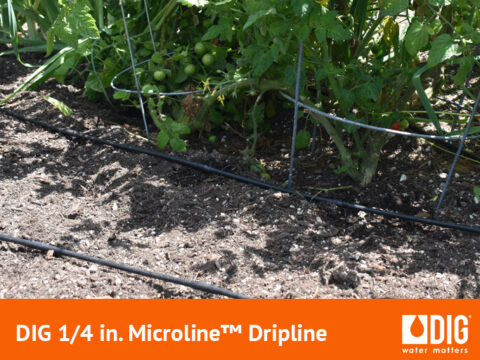1/4 in. Microline™ Dripline
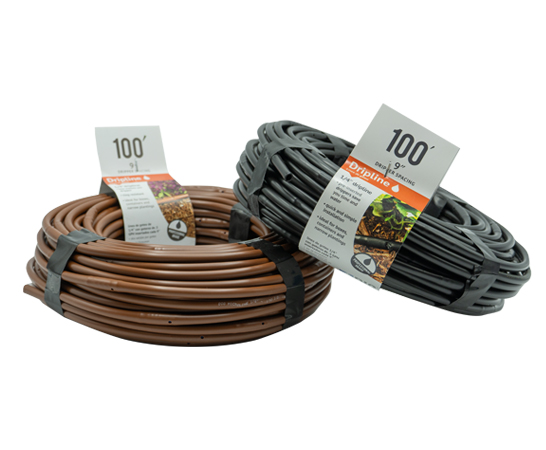

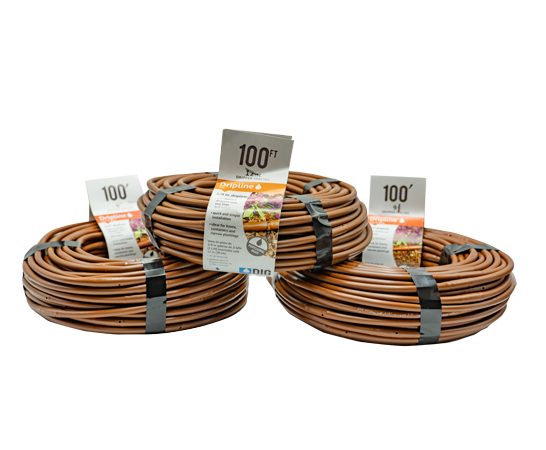
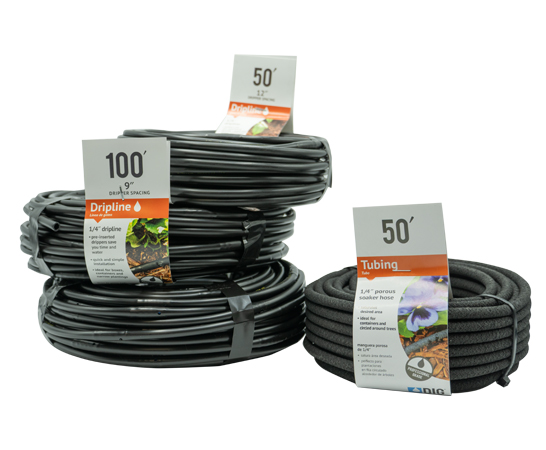
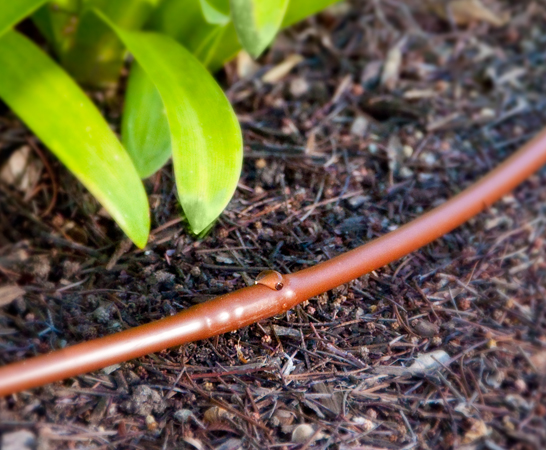
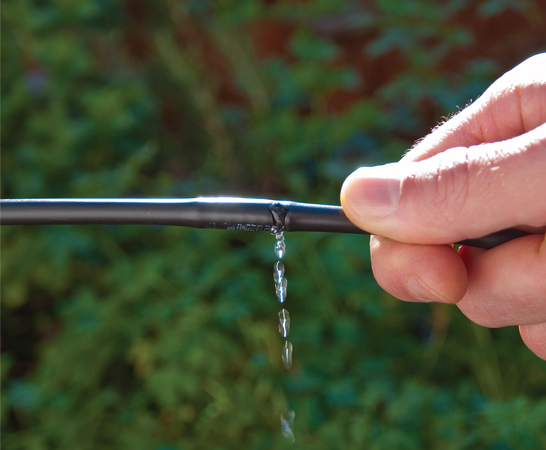
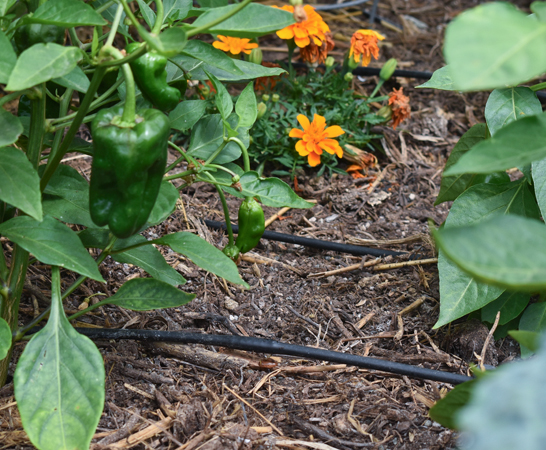
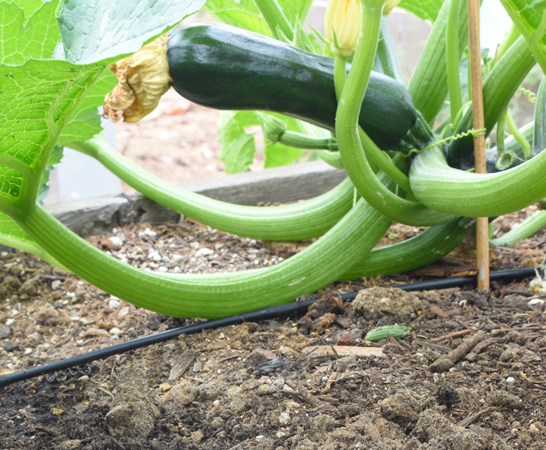
Extremely versatile and flexible, DIG’s 1/4″ Microline Dripline presents key advantages over other irrigation methods, utilizing low-cost, small-diameter dripline that can be used in any part of the garden for a water-efficient drip irrigation system. The dripline’s cylindrical labyrinth drip emitters are inserted into the interior wall of the 1/4” micro tubing every 6″, 9″ or 12″ spacing. It can be installed in a wide range of above-ground application layouts, or used under mulch or bark to conserve water or for aesthetic reasons. The dripline is designed to be extended from the drip tubing or micro tubing using a 1/4″ barb, or attached into our four- or six-outlet drip manifolds. It can be used in planter boxes, vegetable gardens, window boxes, box gardens, looped around individual plants or trees, in narrow paths of planting areas or where total saturation is desired along the drip line path, while eliminating discoloration of fences, windows and walls due to water staining.
Features
- Use for planter boxes, window boxes, closely planted or narrow areas, vegetable gardens, gravity feed systems, green roofs or loop around roses, shrubs and trees
- Connected into any drip system’s drip tubing with ¼” barbed fittings
- Each drip emitter has two outlets for less chance of plugging
- Use for commercial and residential applications
- Allows water to drip directly to the root zone, delivering a constant deep watering
- No special tools or glue are needed
- Can be used in both new and existing landscape areas
- Available in 50’ with 12″ spacing, 100′ with 6″, 9″ and 12″ spacing and 500′ with 12″ spacing
- Saves money by significantly lowering the cost of system components compared to conventional irrigation systems
- Contains UV inhibitors for long life and extended operation in harsh conditions
- Flexible micro tubing for easy installation
- DIG’s drip irrigation products may be exempt from residential and commercial watering restrictions (check local codes)
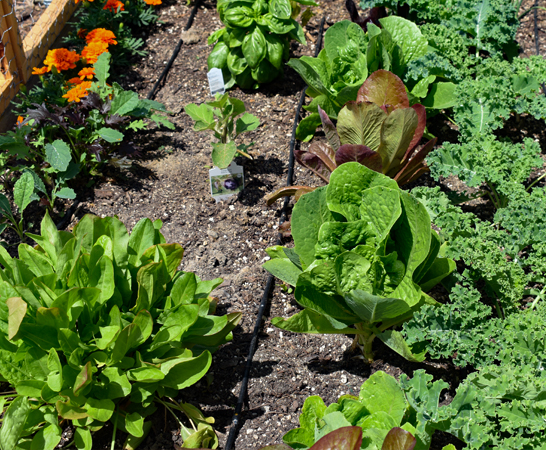
How to Order
| MODEL | DESCRIPTION | COLOR |
|---|---|---|
| Emitter spacing every 12 inches | ||
| SH50 | 50 ft. of 1/4 in. Microline™ with .5 GPH Emitter | Black |
| SH112 | 100 ft. of 1/4 in. Microline™ with .5 GPH Emitter | Black |
| SHB112 | 100 ft. of 1/4 in. Microline™ with .5 GPH Emitter | Brown |
| SH512 | 500 ft. of 1/4 in. Microline™ with .5 GPH Emitter | Black |
| Emitter spacing every 6 inches | ||
| SHB106 | 100 ft. of 1/4 in. Microline™ with .5 GPH Emitter | Brown |
| SH106 | 100 ft. of 1/4 in. Microline™ with .5 GPH Emitter | Black |
| Emitter spacing every 9 inches | ||
| SHB109 | 100 ft. of 1/4 in. Microline™ with .5 GPH Emitter | Brown |
| SH109 | 100 ft. of 1/4 in. Microline™ with .5 GPH Emitter | Black |
Specifications
- Operating pressure range: 10 to 25 PSI
- Flow rate: .65 GPH @ 25 PSI
- Drip emitter spacing: 6", 9" or 12"
- Drip line size: 50’, 100’ or 500' with .170 ID x .250 OD
- Bending radius: minimum 1'
- Two (2) outlets per each drip emitter
- Color: black or brown
- Filter requirement: minimum of 150 mesh
- Material: drip tubing & drip emitters: polyethylene
Drip emitter flow versus pressure
| Pressure (PSI) | Flow (GPH) | Pressure(BAR) | Flow (L/H) |
|---|---|---|---|
| 10 | 0.42 | 0.7 | 1.6 |
| 15 | 0.52 | 1.0 | 2.0 |
| 20 | 0.58 | 1.4 | 2.2 |
| 25 | 0.65 | 1.7 | 2.5 |
Maximum recommended length of single lateral 1/4" drip line @ 25 PSI
| Drip emitters spacing | 6" | 9" | 12" |
|---|---|---|---|
| Average flow rate | .62 GPH | .62 GPH | .62 GPH |
| Maximum length in feet | 16' | 22' | 28' |
| Flow rate in GPM | .33 | .30 | .29 |
| Flow rate in GPH | 19.8 | 18.2 | 17.4 |
| # of drip emitters | 32 | 29 | 28 |
| Head loss in PSI | 5.5 | 6.4 | 7.6 |
| Velocity (f/s) | 4.7 | 4.3 | 4.1 |
About
The 1/4″ Microline Dripline is 1/4″ micro tubing with .65 GPH @ 25 PSI labyrinth-like in-line drip emitters built into the interior wall of the micro tubing at pre spaced intervals of 6″, 9″ or 12″. The drip line’s discharge flow varies with pressures from a low of 15 PSI to a high of 25 PSI, with higher discharge at higher pressures and lower discharge at lower pressures.
Available in two colors, black or brown, the 1/4″ Microline dripline can be used for plantings in preset spacing, in narrow planting areas, for vegetable garden boxes, window boxes, large pots, closely spaced plants in rows, as well as for hedges, groundcovers, shrubs and roses. It can also be used around trees by looping a few rounds of drip line around the tree and connecting it to the drip tubing. The Microline dripline is available in 50’ or 100’ lengths and it is recommended to install a 25 PSI pressure regulator when installing the 1/4″ dripline. For commercial and residential applications, install this dripline above the ground and if desired cover with mulch to blend with the landscape.
Installation suggestions:
Basic installation recommendations for this product include first reviewing the area and then making a drawing of the garden or site with your preferred layout.
If automation is required, use one of DIG’s hose end timers or battery operated controllers. The ideal controller should have flexible scheduling and two to four start times per day for added flexibility.
Start the installation from a PVC pipe or to pipe thread
- If the drip system installation is started from a PVC pipe, first shut off the main water supply.
- If an automated system is preferred, we recommend installing a 3/4” ball valve or gate valve before the battery operated controller or AC valve, if used. This ball valve can be very useful as an emergency backup to turn the system off. This type of arrangement is used by professional installers.
- Turn the water supply on to flush the line and then shut the water supply off using the new ball or gate valve.
- Install an AC valve or battery operated controller, wrapping TEFLON tape on all the male thread fittings used.
- Turn the water supply on again to pressurize the system. The unit will open momentarily and then will shut off.
- Test the valve or the battery operated controller and make sure that valve or battery operated controller is working correctly. If using a battery operated controller, then program the controller.
- After the AC valve or battery operated controller, add a 3/4″ screen filter with 155-mesh (model D55). The screen filter is used to protect the drip system. Next, add a preset 25 PSI pressure regulator (model D46P) or adjustable pressure regulator (model PRV075). The pressure regulator is used to lower the pressure to the suggested operating pressure for a drip system. Follow with a 3/4” swivel adapter (model 50001) to the drip tubing or 3/4” PVC thread x slip adapter to the PVC line.
Start the installation from a faucet or hose thread
- If an automated system is preferred, install a hose end timer.
- Test the hose end timer and make sure that is working correctly, then program it. To the hose end timer, add a backflow device (model D45), then a 25 PSI pressure regulator (model D46) and then a 3/4″ swivel adapter with screen (model C34). If water quality is a concern, we highly recommend using DIG’s fine mesh 3/4″ filter with 155-mesh (model D57A).
Drip line installation
- Use the 1/2″ drip tubing as the main lateral and lay out the drip tubing per your drawing, securing the drip tubing using the stakes (model R60). Use the stake holders to secure the drip tubing or drip line to the ground in key areas and add more stakes as you unroll the drip tubing. Add stakes every 10′-20’ and at the end of each section, or as needed.
- Throughout the installation add 1/2” fittings, if needed, such as tees (model C35) and elbows (model C36) per your drawing layout, leaving the end of the drip tubing open. To install the 1/2″ drip fittings, cut the drip tubing with a hand pruner, being careful to keep dirt from entering the line. Hold the fitting in one hand and the drip tubing or microline dripline in the other and force the drip tubing or dripline into the fitting by wiggling it from side to side.
- Use the 1/2″ drip tubing as the main lateral and connect the 1/4″ microline dripline to the 1/2″ drip tubing per your layout configuration. To connect the 1/4” drip line into the 1/2″ drip tubing, punch a hole into the 1/2″ drip tubing, snap the barbed fitting (model H80A or H80B for 1/4″ barb and model H82A or H82B for 1/4” tee) into the hole and push the end of the microline dripline over the other side of the barb. The 1/4″ fittings are available in barbed connectors, tees or elbows to meet the varying requirements of the installation and layout of the micro tubing and 1/4″ microline dripline.
- Lay the drip line along the planting area or loop the drip line around a tree and secure it to the ground using the stakes (model P31B).
- Turn the water on and flush the line.
- Close the end of the drip tubing using the hose end (model Q58) or figure “8” (model F68B) and then close the end of the 1/4″microline dripline with the large size of the plug (model G79B).
- Pressure-test the system to identify leaks in the drip tubing laterals, fittings and microline dripline and then program the hose end timer or battery operated controller.
About the soil and suggested watering intervals:
- Sandy soil or light textured soil: Water percolates straight through before it can spread far enough horizontally, so apply water at close intervals such as every other day for 20 to 90 minutes depending on plant size and type, daylight conditions (full sun, partial sun or shaded), and weather pattern (cold to hot) with the plants under full sun in hot conditions getting the longer period.
- Loamy soil or medium textured soil: This is the ideal soil condition with water moving slowly and spreading evenly, so apply water at wider intervals such as every two to four days for 15 to 90 minutes depending on plant size, type, daylight conditions (full sun, partial sun or shaded), and weather pattern (cold to hot) with the plants under full sun in hot conditions getting the longer period.
- Clay soil or heavy textured soil: Water is absorbed very slowly, so apply water at longer intervals such as every three to five days for 30 to 60 minutes depending on flow rate, plant size and type, daylight conditions (full sun, partial sun or shaded), and weather pattern (cold to hot) with the plants under full sun in hot condition getting the longer period.
